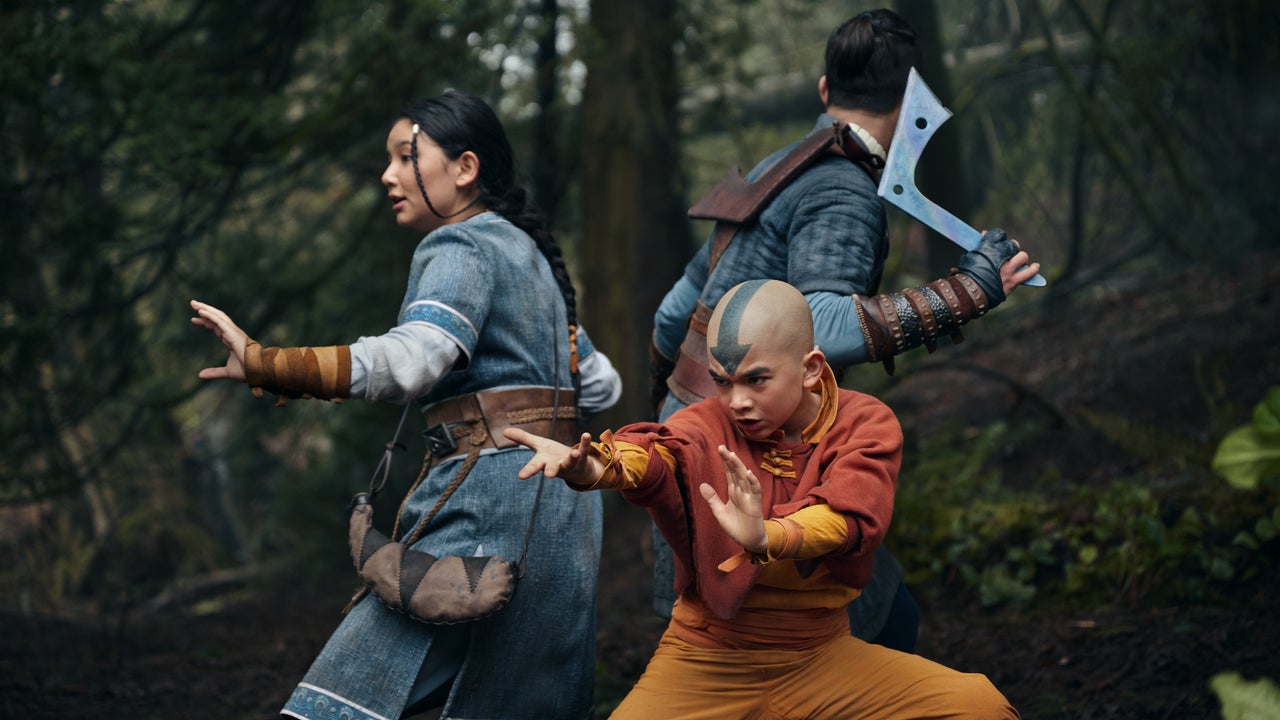I think one of the big questions is, despite all the remixing, is the point A and the point B still the same as the original?
AK: Pretty much. Yeah, I mean, I think the state of the world and the stakes of the world are still the same. So we decided to make Aang’s narrative drive a little clearer. In the first season of the animated series, he’s kind of going from place to place looking for adventures. He even says, “First, we’ve got to go and ride the elephant koi.” It’s a little looser as befits a cartoon. We needed to make sure that he had that drive from the start. And so, that’s a change that we made. We essentially give him this vision of what’s going to happen and he says, “I have to get to the Northern Water Tribe to stop this from happening.” That gives him much more narrative compulsion going forward, as opposed to, “Let’s make a detour and go ride the elephant koi,” that type of thing. So that’s something, again, that’s part of the process of going from a Nickelodeon cartoon to a Netflix serialized drama.



We have to remember that the original creators of ATLA wanted originally to do 10-12 episodes per season but at the time, the standard length of an American television show was twenty episodes per season. I love ATLA but there is filler - especially in Season 1. It does usually contribute to the story but it is filler. Because of the season length, narrative beats that could happen with tighter writing are spread out over multiple episodes.
With nostalgia glasses, I think many don’t see just how wonky Season 1 is. I don’t think it really hits its stride until the Blue Spirit episode. And even then, it is still getting its narrative legs for most of Season 1. Seasons 2 and 3 handle their length much better IMO.
There is a way to do the narrative arcs of Season 1 in ten episodes. Narratives can be combine into the same episodes that were originally over multiple ones.
I don’t expect a one-to-one adaptation. That would be boring. As long as the core remains, I’m happy to let them remix. You don’t go to the theater expecting to see the same Hamlet year after year, do you?
Honestly I don’t agree. With the sole exception of The Great Divide, I think every episode in the season adds something important. There might be a little room to tighten it up, but it would be hard to remove entirely without losing something.
The first two episodes do so many important things. You could maybe tighten it up a little, but not much. You need to establish that Aang is both a fun happy-go-lucky kid, but also one who is aware the weight of the world is on his shoulders. You need to establish Zuko’s inner conflict, and the dynamic of Sokka and Katara. And, obviously, set up the wider world, establish the Fire Nation as baddies, the Avatar as powerful, the nature of bending, etc.
The Southern Air Temple hammers home the Air Nation genocide’s significance, and as well as establishing the Avatar’s reincarnation cycle.
The Warriors of Kyoshi is a comparatively more filler type episode, but it’s important in Sokka’s growth in terms of the obvious growing-out-of-sexism arc, but also in showing how non-benders (including him, as well as the Kyoshi warriors—who become more important later) are able to put up a serious fight. The destruction left by Zuko helps hammer home how ruthless the Fire Nation is in a more immediate and direct manner than the previous episode’s allusion to events of a century ago.
The King of Omashu probably the second-most skippable of the season. But it establishes King Bumi, who obviously becomes important later both as a member of the White Lotus and in terms of his talk about neutral jing, and it establishes the first major city that we see, and one which is important later when it gets captured by the Fire Nation—a beat that is a lot less powerful if we don’t already have a good connection to it.
Imprisoned is important because it gives us a brilliant performance by George Takei. 'nuff said. No but seriously, this is the first episode since the pilot that gives us a deep focus on Katara and her more justice-focused personality than the other characters. It’s also our first serious look at the colonial nature of the new Fire Nation empire. Less importantly, it’s collecting our first character who is later involved in the Day of Black Sun invasion.
Winter Solstice Part 1 establishes the rules for the Spirit World and the Tolkienesque “importance and power of nature” theme. Part 2 is much more important in its direct plot significance.
The Waterbending Scroll gives us: the first hint of the White Lotus, the pirates who will later be used to blow up Zuko’s ship, the start of the very personal animosity between Zuko and Katara (an important part of both their character arcs), a demonstration of Aang’s natural aptitude and Katara’s work ethic, evidence of the two of them studying at waterbending.
Jet is another relatively skippable one, except that it shows us for the first time how there are evils on both sides, even if the evils on one side far outweigh the other. An important theme with Ba Sing Se in season 2.
Then there’s The Great Divide, which we’ll skip for obvious reasons, followed by The Storm, which I cannot believe isn’t the episode you listed as the one where “it really hits its stride”. It not only provides the necessary set-up for The Blue Spirit, but it gives us the critical backstory to understanding who Aang and, much more importantly, Zuko, are. It shows us Aang’s heroic flaw, and the spark that ends up leading to Zuko’s redemption. (Also, weird side note: this Wikipedia page about character flaws honestly reads more like a TV Tropes article, replete with dozens of specific examples from different media, ranging from Macbeth to Aang to an entire section on the show Once Upon a Time.)
I was originally going to do the whole season, but this has already gotten long enough, and I’ve caught up with where you said it finally lands, so I’ll stop.
Am I saying that the adaptation is automatically going to fail because it’s leaving some of these out? No, absolutely not. In fact I think for the way most TV is told these days they’re probably making the right decision. More highly-serialised longer episodes are kind of by definition going to necessitate certain more fundamental structural changes, and collapsing many of these arcs and themes into side plots within the same episode. So no, I’m not criticising the live action showrunners based on what we’ve seen so far.
But I am saying that the original show does a much better job than I think you give it credit for of using its episodes well, and that cutting much out of even the first season would be difficult in the context of a 22-minute episodic cartoon. In fact I think Avatar is perhaps the most perfect example there is of a TV show that uses episodic storytelling to its fullest potential. Each episode is fully capable of standing on its own (something most more serialised shows cannot claim), while also forming a crucial part of the greater whole.
Upvoted for very detailed answer
Thanks so much for your very detailed comments. And I take many of your points. I think you are largely right - perhaps I need to go back and rewatch the show because it has been a while. And I think you are right that ATLA is uniquely well-balanced between its serialized elements and its larger narrative.
Also, I think we agree on a fundamental point I was trying to make:
The conventions or parameters of the live-action show (longer episodes on a streaming service) mean that structural changes will happen. The original show had to work within certain parameters and the new one will have to as well. I am excited to see how they tell the story in a new way with those conventions or parameters. We have a lot of movements and story beats for each character but can they get there in different way that ultimately leads us to the same place?
The perfection of the original show was in that they took their story and worked within the conventions. In other words, I think that if they were making the show now, they would do things differently. That can bee seen in how they approached The Legend of Korra. They found a way to work within the need for 20 episodes by making sure each episode did count towards something (the Great Divide being the exception).
Another thing that just popped into my mind as I was writing is that if you take the total number of minutes, the Live Action show will actually have more time to tell its story than the original show (Original ATLA - 20 episodes at 22 minutes each = 440 minutes versus Live ATLA - 10 episodes at 60 minutes = 600 minutes). But because the episodes will be only 10, you will need to remix things.
Thanks again for your comment!
Very good reminder